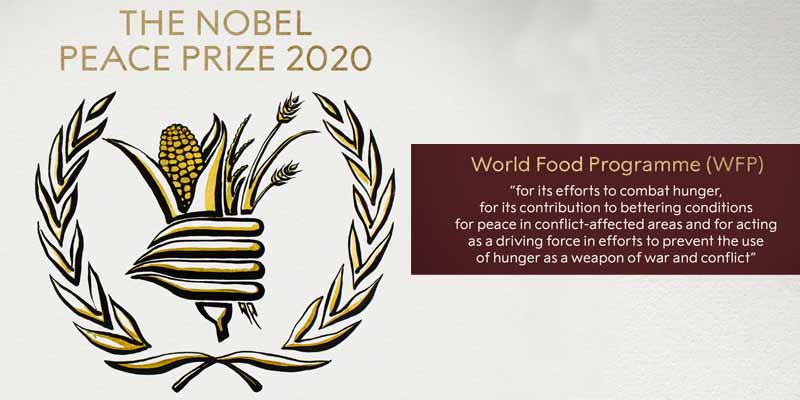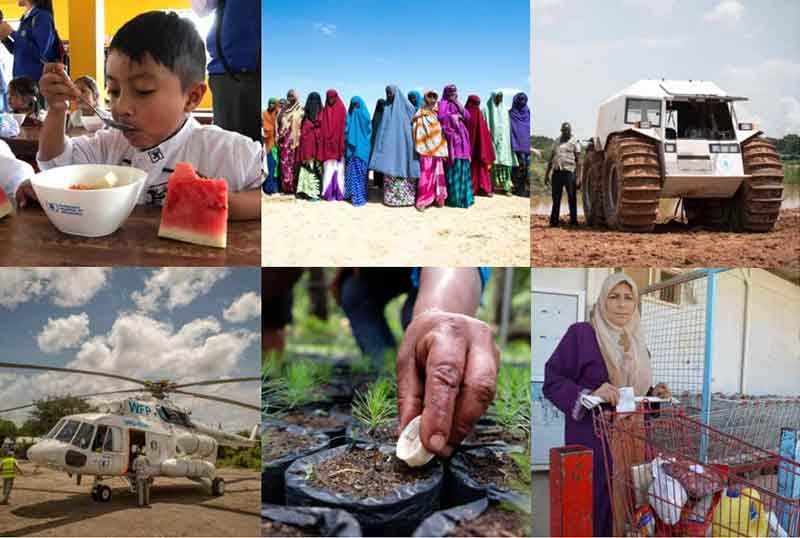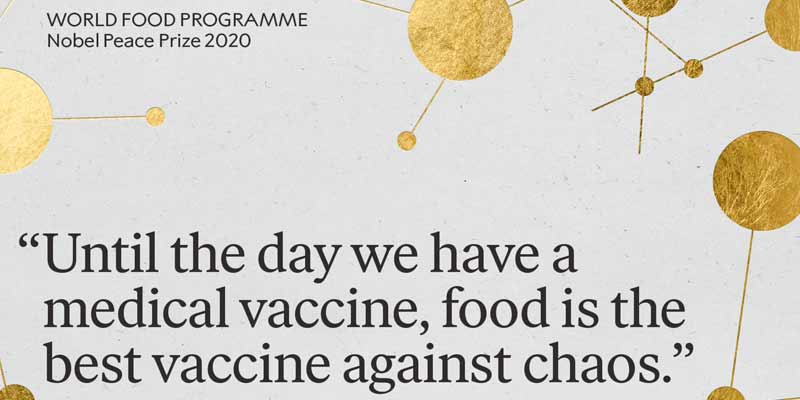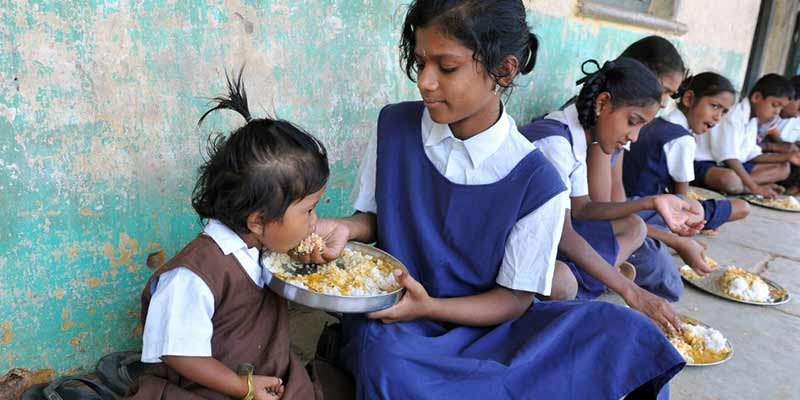- World
- Oct 09
UN’s World Food Programme wins Nobel Peace Prize
The United Nations’ World Food Programme (WFP) won the Nobel Peace Prize for its efforts to combat hunger, contribution to bettering conditions for peace in conflict-affected areas and acting as a driving force in efforts to prevent the use of hunger as a weapon of war and conflict.
With this year’s Award, the Norwegian Nobel Committee wishes to turn the eyes of the world towards the millions of people who suffer from or face the threat of hunger.
World Food Programme
The World Food Programme (WFP) is a UN agency saving lives and changing lives, delivering food assistance in emergencies and working with communities to improve nutrition and build resilience.
The WFP’s efforts focus on emergency assistance, relief and rehabilitation, development aid and special operations. Two-thirds of its work is in conflict-affected countries where people are three times more likely to be undernourished than those living in countries without conflict.
The WFP was introduced in 1961 after the 1960 Food and Agriculture Organization (FAO) Conference, when George McGovern, director of the US Food for Peace Programmes, proposed establishing a multilateral food aid programme. The WFP was formally established in 1963 by the FAO and the UN General Assembly on a three-year experimental basis. In 1965, the programme was extended to a continuing basis.
The WFP is governed by a 36-member executive board. It works closely with its two Rome-based sister organisations, the FAO of the United Nations and the International Fund for Agricultural Development. The WFP partners with more than 1,000 national and international NGOs to provide food assistance and tackle the underlying causes of hunger.
The WFP is the largest humanitarian organisation implementing school-feeding programmes worldwide and has been doing so for more than 50 years. Each year, the WFP provides school meals to more than 16 million children in 60 countries, often in the hardest-to-reach areas.
The WFP purchases 3 million metric tonnes of food every year. At least three quarters of it comes from developing countries.
From air-dropping food in South Sudan to creating an emergency delivery service to keep aid flowing despite coronavirus travel restrictions, the Rome-based organisation has long specialised in getting assistance to some of the world’s most dangerous and precarious places.
In 2019, WFP assisted 97 million people – the largest number since 2012 – in 88 countries.
On any given day, WFP has 5,600 trucks, 30 ships and nearly 100 planes on the move, delivering food and other assistance to those in most need.
Funded entirely by voluntary donations, WFP raised a record-breaking $8 billion in 2019. It has more than 17,000 staff worldwide of whom over 90 per cent are based in the countries where the agency provides assistance.
Zero Hunger programme
Every day too many men and women across the globe struggle to feed their children a nutritious meal. In a world where we produce enough food to feed everyone, 690 million people still go to bed on an empty stomach each night. Acute food insecurity affected 135 million people in 55 countries in 2019. Even more – one in three – suffer from some form of malnutrition.
Eradicating hunger and malnutrition is one of the great challenges of our time. Not only do the consequences of not enough – or the wrong – food cause suffering and poor health, they also slow progress in many other areas of development like education and employment.
In 2015 the global community adopted the 17 Global Goals for Sustainable Development to improve people’s lives by 2030. Goal 2 – Zero Hunger – pledges to end hunger, achieve food security, improve nutrition and promote sustainable agriculture. The WFP is the UN’s primary instrument for realising this goal.
The WFP and its partners work to bring us closer to a Zero Hunger world. The World Hunger Map will help to guide global hunger and operations to end scourge by 2030. It also aims to improve efficiency of interventions and shorten emergency response times.
The link between hunger and armed conflict
In 2019, 135 million people suffered from acute hunger across the globe, the highest number in many years. Most of the increase was caused by war and armed conflict.
The coronavirus pandemic has contributed to a strong upsurge in the number of victims of hunger in the world. In countries such as Yemen, Democratic Republic of Congo, Nigeria, South Sudan and Burkina Faso, the combination of violent conflict and the pandemic has led to a dramatic rise in the number of people living on the brink of starvation.
In the face of the pandemic, the World Food Programme has demonstrated an impressive ability to intensify its efforts. As the organisation itself has stated, “Until the day we have a medical vaccine, food is the best vaccine against chaos.”
The world is in danger of experiencing a hunger crisis of inconceivable proportions if the WFP and other food assistance organisations do not receive the financial support they have requested.
The link between hunger and armed conflict is a vicious circle: war and conflict can cause food insecurity and hunger, just as hunger and food insecurity can cause latent conflicts to flare up and trigger the use of violence. We will never achieve the goal of Zero Hunger unless we also put an end to war and armed conflict.
The Norwegian Nobel Committee emphasises that providing assistance to increase food security not only prevents hunger, but can also help to improve prospects for stability and peace.
The WFP was an active participant in the diplomatic process that culminated in May 2018 in the UN Security Council’s unanimous adoption of Resolution 2417, which for the first time explicitly addressed the link between conflict and hunger. The Security Council also underscored UN Member States’ obligation to help ensure that food assistance reaches those in need, and condemned the use of starvation as a method of warfare.
The WFP plays a key role in multilateral cooperation on making food security an instrument of peace, and has made a strong contribution towards mobilising UN Member States to combat the use of hunger as a weapon of war and conflict.
As the UN’s largest specialised agency, the WFP is a modern version of the peace congresses that the Nobel Peace Prize is intended to promote, the Committee said.
WFP and India
India is home to a quarter of all undernourished people worldwide, making the country a key focus for tackling hunger on a global scale. In the past two decades, per capita income more than tripled, yet the minimum dietary intake fell. The gap between rich and poor increased during this period of high economic growth.
The WFP has been working in India since 1963, with work transitioning from food distribution to technical assistance since the country achieved self-sufficiency in cereal production. With the government now providing its own food distribution systems, the WFP’s work focuses on supporting the strengthening of these systems to ensure they become more efficient and reach the people who need them most.
WFP is working to improve the efficiency, accountability and transparency of India’s own subsidised food distribution system, which brings supplies of wheat, rice, sugar and kerosene oil to around 80 crore people across the country. WFP ensures that food reaches those who need it most, working with the government to reform and strengthen the system, which is one of the world’s largest.
To boost the nutritional value of the government’s Midday Meal programme, WFP is pioneering the multi-micronutrient fortification of school meals. The pilot project saw rice fortified with iron, which was distributed in a single district, resulting in a 20 percent drop in anaemia. WFP also helps tackle malnutrition by fortifying food given to babies and young children in Kerala.
The UN agency uses its own Vulnerability Analysis and Mapping software to identify India’s most food insecure areas, which allows policy and relief work to be targeted appropriately.
Manorama Yearbook app is now available on Google Play Store and iOS App Store




